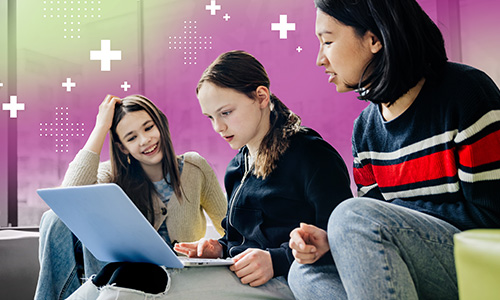
My best friend sent me a hilarious text the other day: “If you see me talking to myself this week, mind your business. I’m having a parent-teacher conference.”
She’s a stay-at-home mom of two trying to figure out how to follow through on the lessons her kindergartener’s teacher is sending home while also tending to her three-year-old and the numerous day-to-day tasks that haven’t gone away, like laundry, walking the dog, and keeping everybody fed.
Meanwhile, I’m writing this post on a Sunday afternoon, my 3-year-old at my side watching I’m-not-exactly-sure-what on a tablet and his 1-year-old sister napping. (That’s a gratuitous picture of them.)
Like so many parents across the country, we’re in unfamiliar territory and making it all up as we go. Here are some tips and resources I hope can help you support your kids—and preserve your mental health—during school closures. Take what works for you and leave the rest.
1. Breathe
I’m amazed at how often I have to remind myself to breathe. And not just when there’s a global pandemic to worry about. Lung-filling breaths are the first thing to go when the going gets rough, but there are few things that can clear my head and help me deal with whatever is coming my way better than focusing on my breathing. The science behind why is pretty interesting.
[W]e’re in unfamiliar territory and making it all up as we go.”
Pause to take a few breaths when you feel your stress levels get high. You can even have your kids take some with you. You’ll likely only need 30 seconds or so to get the calming effects you’re after. (If you’re up for taking your breathing a step further with mediation, Headspace is offering free services as we all struggle to deal with the coronavirus crisis.)
2. Stick to a schedule
Kids are used to a routine when they’re at school, whether they’re in kindergarten or high school. You’re probably used to a routine, too. You pack lunches, drop the kids off, then savor a coffee while you check your email at work.
Routine has numerous mental health benefits, so during these chaotic times, try to establish one that works for you and your family. For example, you could follow your pre-coronavirus routine for getting everyone ready to get out the door every morning. Then tack on your new normal. Here’s what it might look like if you have young kids and are lucky enough to be able to work from home and have flexible hours:
7:30–8 Story time to get brains going and ease into the day
8–10 School work with the kids
10–12 A little TV (check out We Are Teachers’ handy list of educational shows on Netflix), then a creative hour of Play-Doh, coloring, Legos, or Magna-Tiles while you work
12–12:30 Lunch together, complete with opportunities to talk about what the kids learned in the morning or to practice adding and subtracting Goldfish or carrot sticks
12:30–1 Some fresh air (it’ll do everyone good)
1–3 School work with the kids
3–5 Kid movie or educational app time while you work
5–8 Family time, dinner, and story time before lights out
8–10 Work time
3. Create a learning space
If you can, set aside a specific part of your home for learning. Your kitchen table could be a good spot, especially if you’re working from home and have to juggle teaching, keeping your kids out of trouble, and doing your job. A learning space can make it easier for everyone to transition from school work to other activities and to keep some boundaries between the many activities getting blurred together right now.
4. Talk about feelings
Upheaval and uncertainty are difficult for everyone, and overwhelming emotions can make it more difficult for children to learn. The Collaborative for Academic, Social, and Emotional Learning (CASEL) has free resources about social-emotional learning (SEL) on their website that can guide your conversations with your children during these difficult times.
Routine has numerous mental health benefits, so during these chaotic times, try to establish one that works for you and your family.”
If you need someone to talk to, rest assured you’re not the only one. Ask your health plan if you’re covered for telehealth appointments with a mental health provider, or call a friend or family member.
The only certain thing is uncertainty
It’s hard to know when things will get back to normal. Anxiety will come and go. So will cabin fever. Hopefully these trying times will also be filled with many midday hugs from your kids, high fives while learning together, and opportunities to offer yourself a little grace. This is hard, and you’re doing great.







